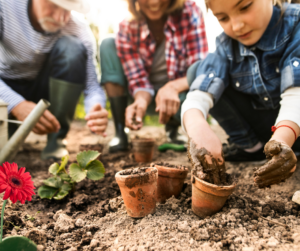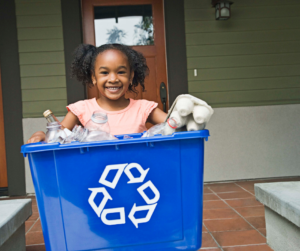Environmental education is a beautiful way to blend science, creativity, and outdoor exploration into your homeschooling curriculum. Earth Day is often celebrated with events and activities, but its message can inspire learning and action every day of the year.
By focusing on practical ways to reduce waste, engage with nature, and spark creativity, parents can create an ongoing appreciation for the environment. Here are some ideas to make Earth Day a year-round effort.
Hands-On Science Projects to Reduce Waste
Science projects are a fantastic way to teach children how their actions can make a direct impact on the environment. Here are practical projects that focus on reducing waste while engaging young minds:
- Composting at Home
Create a simple indoor or outdoor compost bin. Teach kids how food scraps and yard waste can break down into nutrient-rich soil instead of going to a landfill. They’ll learn about decomposition, the role of microorganisms, and how compost benefits plants. Challenge them to track how much waste is diverted from the trash over a week or month. - DIY Recycled Paper
Show children how to recycle scrap paper into handmade sheets. All you need is shredded paper, water, a blender, and a mesh screen. The process demonstrates how materials can be reused instead of discarded and can lead to beautiful creations like homemade cards. - Plastic-Free Experiment
Task your kids with identifying ways to eliminate single-use plastics in your home. For instance, they can test reusable alternatives like beeswax wraps or silicone bags and document how they hold up. This activity combines scientific observation with sustainability. - Upcycling Art Projects
Encourage kids to turn old or discarded items into something new. For example, they can transform mason jars into planters or create art from bottle caps. This project emphasizes the concept of repurposing waste, making it both educational and fun.
Outdoor Adventures in Your Backyard or Local Park
Nature offers a wealth of learning opportunities that go far beyond a textbook. Outdoor activities not only foster environmental education but also provide kids with fresh air and the chance to observe the natural world up close. Here are some ideas for turning outdoor spaces into living classrooms:
Backyard Exploration

You don’t need a sprawling forest to teach kids about nature. Start by encouraging them to look for insects, birds, or plant species in your backyard. Create a simple field guide with drawings or notes on what they discover. A magnifying glass can make this even more engaging as they observe small details about leaves, soil, or bugs.
Take the lesson further by starting a small garden. Kids can learn about seed germination, the importance of pollinators like bees, and how soil health impacts plant growth. A garden can also tie back to composting lessons, giving them the full cycle of growth, waste, and renewal.
Park-Based Learning Adventures
Local parks are incredible resources for homeschooling. Pack a backpack with sketchbooks, water bottles, and snacks, and head out for a day of discovery. Here are a few simple activities to plan at the park:
- Tree Identification Walk
Bring along a guide to local tree species and help kids identify them by their leaves, bark, or fruit. You can also discuss the role trees play in producing oxygen and absorbing carbon dioxide. - Nature Scavenger Hunt
Create a checklist of items to find, such as pine cones, wildflowers, feathers, or different types of rocks. This activity builds observational skills and connects kids to their surroundings in a fun, interactive way. - Stream Study
If there’s a stream or pond nearby, investigate the water. Look for aquatic life like insects or tadpoles. Explain how clean water impacts ecosystems and discuss simple ways to prevent pollution in waterways.
Writing Prompts That Imagine a Greener Future
Creative writing is a powerful way for children to process and express their thoughts on the environment. It encourages them to think critically about problems and imagine positive solutions. Here are some writing prompts you can use to spark their imaginations:
“Imagine a world where plastic has been replaced by a material that disappears after being used. Write a story about how people invented it and what life is like now.”
“Write a letter to someone living 100 years in the future. Tell them what you’re doing today to protect the planet.”
“If trees could talk, what stories would they tell about the people and animals who live around them? Write a journal-style entry from the perspective of a tree.”
“Create a poem describing how the seasons change in your neighborhood and how animals and plants adapt to each one.”
“Design your own eco-friendly superhero. What kind of powers do they have, and how do they inspire others to protect the planet?”
By encouraging children to write about environmental issues, you help them reflect on their role in creating a greener future. Writing assignments can be as structured or as free-flowing as your child needs, allowing them to express their feelings in their unique way.
Building Eco-Friendly Habits at Home
Beyond special projects and activities, one of the simplest ways to integrate environmental education into your homeschool routine is by modeling eco-friendly habits as a family. These habits can serve as daily reminders of the importance of caring for the Earth.

Start by setting up a recycling station at home. Teach kids how to sort paper, plastic, glass, and metal properly. They can take ownership of maintaining the station and checking what’s recyclable in your community.
Next, focus on energy conservation. Kids can learn about the importance of turning off lights, unplugging devices, and conserving water. Make it a game to see who can find the most ways to save energy around the house.
Another great idea is having a “waste-free lunch” challenge. Task your kids with planning meals that generate zero trash, using containers, cloth napkins, and reusable utensils. This small activity helps reinforce the larger concepts of reducing consumption and being mindful of waste.
Fostering Lifelong Environmental Education Awareness
When children grow up immersed in lessons about sustainability, reducing waste, and protecting nature, they’re more likely to carry these values into adulthood. Environmental education shouldn’t feel like a chore for you or your kids. Instead, it’s a chance to explore the world, spark creativity, and encourage habits that last a lifetime.
By weaving science experiments, outdoor adventures, creative writing, and eco-friendly practices into your homeschool, you can make every day feel like Earth Day. Small, consistent efforts add up over time, and your kids will be well-equipped to imagine and create a brighter, greener future.





